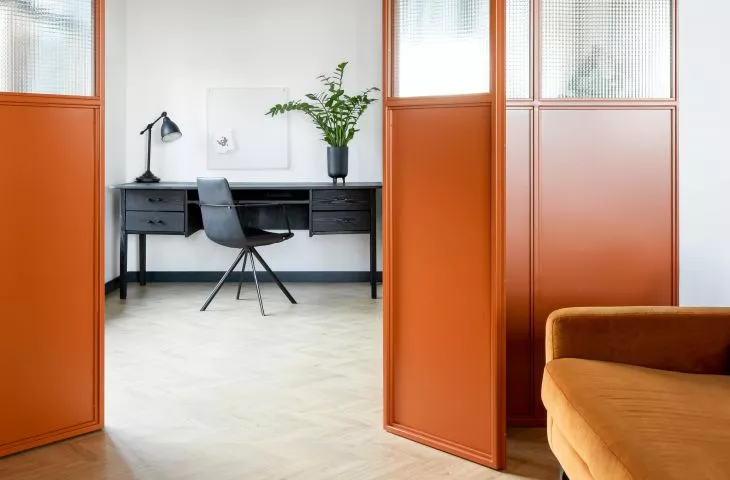Wooden plywood, orangish and white tiles, that's how the Gdansk apartment designed by Barbara Klimek of BARAK Studio can be described in a nutshell. The investors approached the architect with a request to create an interior to which they would always want to return. And so on seventy square meters a space full of light, intimate and filled with books was created.
The apartment, surrounded by greenery and intimate buildings, is located a few steps from Downtown. Its owners are a young family of two who appreciate contrasts - a combination of modern design solutions with vintage , old elements and warm and cold colors. Situated on a sunny side, the apartment is filled with daylight that penetrates through the large glazed windows. The greenery outside the window slightly obscured by aluminum blinds allows you to forget about the proximity to the city center. An interesting element is the corridor, which does not only have a communicative function - with the help of a simple wooden bookcase it was transformed into a library.
The architect wanted to create a place to which one would always want to return
Photo: Jakub Nanowski PERSPEKTYWA © Pracownia BARAK
Dobrawa Bies: What were the assumptions and design inspirations? Did you manage to achieve all of them?
Barbara Klimek: The main design assumption was to create a place to which one would always want to return. Was it easy? I don't know! But I was very keen on achieving coziness. The apartment is located in a cozy development a few steps from Downtown, and you don't feel it at all. The omnipresent greenery helped a lot in achieving the effect of intimacy. It was also important to take advantage of daylight, hence the change in the functional layout and the opening of the study to the living room. Thanks to a light orangish div ider, it was possible to illuminate the two rooms and optically enlarge the space. It seems to me that we managed to create a good place to live - at least that's what the investor says.
The investors wanted warmth, plywood and to weave elements with history into the interior
Photo: Jakub Nanowski PERSPEKTYWA © Pracownia BARAK
Dobrawa: How do you plan your apartment space wisely?
Barbara: Our studio approaches each project individually. From the very beginning, we try to think about functionality, the needs of the investor, but just as much about aesthetic issues. We care that what is important is exposed, and what can be hidden is just that. We don't like cluttered space, hence plenty of storage space.
To enhance the warm effect of the interior, the designer used an orangish color
Photo: Jakub Nanowski PERSPEKTYWA © Pracownia BARAK
Dobrawa: What did the investors expect? Did the cooperation go easily?
Barbara: You can say that, because I was given a free hand. On the one hand, it was my dream, and on the other, the fear that if I didn't like something at the end, it might be too late to change it. Fortunately, the result was met with great enthusiasm from investors. What did they expect? Warmth, plywood and weaving elements with history into the design, such as a clock from one great-grandfather and a radio from another, a coffee table or a medical display case.
Black accents and terrazzo are visible in the bathroom
Photo: Jakub Nanowski PERSPEKTYWA © Pracownia BARAK
Dobrawa: What is the reason for such a combination of colors and materials?
Barbara: The materials and color scheme of the project result from a combination of the investors' expectations and my creation. The selection of materials is my beloved part of the design process. In order to conquer the effect of the warmth brought by the natural-colored plywood, I decided on shades of orangish, which were broken with black accents in the form of chairs, lamps or accessories. The walls throughout the apartment were painted white except for the hallway with anthracite trim, nevertheless the interior gives the impression of color. Metal elements such as blinds, gently letting light into the interior, an orange partition filled with reinforced glass, an old doctor's piece of furniture or flower pots are an expression of the industrial character of the place where we are located, which is the Tricity.






































































